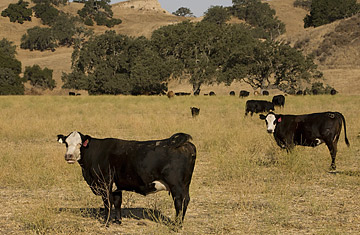
A herd of cows graze in a pasture in Santa Ynez Valley, Santa Barbara County, California
Carbon dioxide gets most of the attention in conversations about climate change, but there are other molecules that deserve some of the blame for the earth's rising temperature, including methane, which a study a few weeks ago reported was bubbling up from the Arctic seafloor.
Now a new report published on Wednesday in Nature addresses the impact of another greenhouse gas: nitrous oxide, or N2O, which is about 300 times as powerful as CO2 at trapping heat in the atmosphere. As with CO2, atmospheric concentrations of N2O have been boosted by human activity, mostly agricultural, by about 16% since the Industrial Revolution began.
But the Nature study throws an unexpected twist into the N2O story. Biologists had long assumed that the farming of cattle and other livestock was part of the reason for rising nitrous oxide levels, because the animals' grazing disrupts the natural cycle that draws nitrogen into the soil. Instead, according to new research, it turns out that in some places, grazing actually reduces N2O emissions. "It's quite surprising," says Steve Del Grosso, a soil scientist with the U.S. Department of Agriculture's Agricultural Research Service in Fort Collins, Colo., who wrote a commentary accompanying the research in Nature.
The field research took place in Inner Mongolia, where frigid winters are followed by relatively balmy summers — a cycle that turns out to be key. "Grazing is like mowing," says study co-author Klaus Butterbach-Bahl, a professor at the Karlsruhe Institute of Technology in Garmisch-Partenkirchen, Germany. "It keeps the grasses short. When winter arrives, tall, ungrazed grasses trap the snow, forming an insulating blanket that keeps the soil below at a relatively warm 16°F or so."
On grazed land, by contrast, the snow just blows away, exposing the ground more or less directly to the chilly air and driving subsurface temperatures down to a few degrees below zero. At these temperatures, says Butterbach-Bahl, soil microbes — some of which emit N2O — can't easily survive. When the ground finally thaws in spring, the ungrazed grass not only has microbes ready to start churning out nitrous oxide, but also snowmelt to provide the water it needs to thrive. On grazing land, we see far less microbial activity, says Butterbach-Bahl.
Both Butterbach-Bahl and Del Grosso are quick to point out that the new findings cast no doubt on the fact that N2O contributes to climate change or on the fact that human-related agricultural factors (including soil and animal-manure management), along with chemical manufacturing, have driven atmospheric levels higher. The value of the new research, says Del Grosso, is that "it can give us a better understanding of where the emissions are actually coming from, so we can figure out where to concentrate our mitigation efforts."
Given that these results would apply to about a third of the earth's grasslands, which themselves cover about 20% of the land surface in temperate regions, that's important information: the Nature study figures that scientists may have overestimated N2O emissions from these areas over the past 100 years by as much as 72%.
But there's another caveat. "You can't look at grazing in isolation," says Del Grosso. "It might reduce N2O emissions, but cattle and other livestock generate heat-trapping methane when they digest food. Grazing can also lead to soil erosion, and it can alter the ecosystems in other ways as well."
In short, this is a study whose results are surprising, and clearly significant — but whose place in the bigger picture of how to deal with climate change remains to be seen.
Lemonick is the senior science writer at Climate Central.
